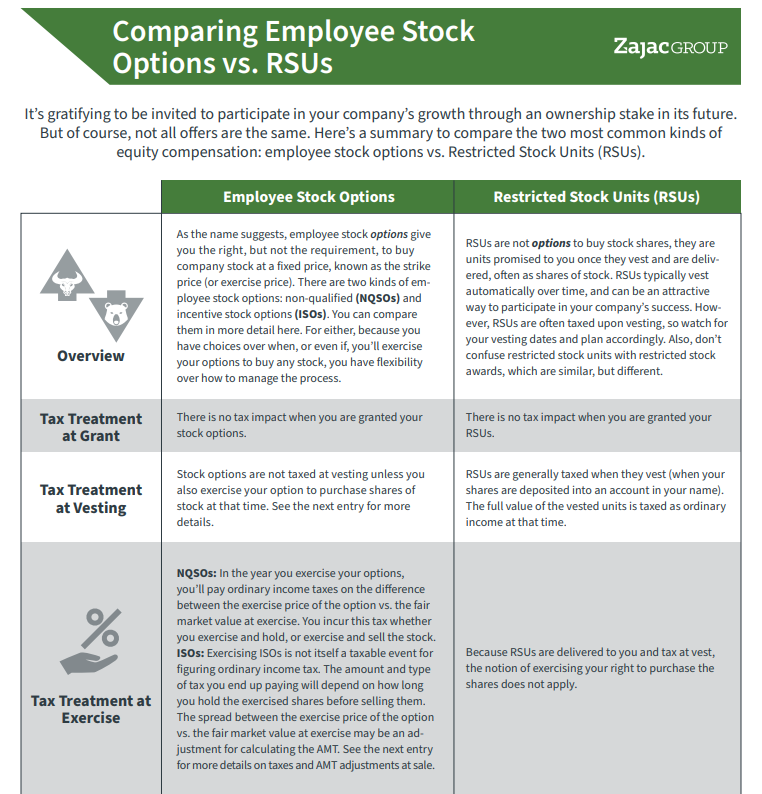
However, knowing the right moves to maximize this complicated form of equity compensation is no easy task. You may need to consider things like income tax, alternative minimum tax, holding periods, vesting schedules, concentrated equity, valuations, etc. In other words, it’s easy to become overwhelmed.
Instead of being paralyzed by that complexity, you should focus your energy on asking some key questions, both of which are actually quite simple: “How do I feel about my company stock? How much company stock do I want to hold?” “And how does this fit into my financial plan?”
Your answers to these questions should dictate how you develop a plan and implement a strategy to achieve your goals.
In my experience, every client answers these questions differently, but their answers all seem to fall under one of these three mentalities:
- I think the stock is going to continue to go up. I want to keep as many company shares as possible.
- I have too much tied up in my company already. I want to sell my employee stock options as soon as possible and diversify.
- I want the best of both worlds. I’ll keep some shares and diversify the others.
Unfortunately, it’s not so easy. This is just the beginning. Let’s take a closer look at what each one of these goals means for your long-term financial plan.
COMPARISON GUIDE
Not All Stock Offers are the Same! Here's a helpful comparison between two of the most common employee stock options.
Exercise and Hold As Many Employee Stock Options as Possible
You have to bet big to win big. For some, betting big on company stock ownership is a risk that they are willing to take.
If you exercise and hold as many shares as possible, 0r simply wait to exercise unvested options, you will continue to accumulate and hold the maximum amount of stock. The primary goal subsequently is to obtain, maintain, and concentrate a large portion of one’s net worth in the company stock.
If the company stock price goes up, then you will be a big winner. If, however, the company stock goes down, then you could lose big…. potentially very big!
To implement this strategy, you may hold restricted stock units after they vest. You could use cash to exercise non-qualified and incentive stock options (simply known as a “cash exercise”), or leave them unexercised after they vest. With a cash exercise, the employee is often using “other” personal assets to buy more and more shares of the same company.
Treat Employee Stock Options as Compensation
Many who receive company stock or employee stock options decide to treat those shares as compensation. This means that you will sell your shares of the company stock as soon as possible (immediately upon vesting), exercise and sell your employee stock options, and then reinvest the proceeds into a diversified portfolio elsewhere.
By following this strategy, you generally make no attempt to be tax-efficient, time the market, and/or play other investment “games.” The goal is simple – to sell the company stock as soon as possible in order to diversify and reinvest elsewhere. Quite simply, this strategy often means you have no interest in holding the stock.
This might be the right strategy to implement if you feel that a significant part of your life is already tied up in one company, including your income, your health benefits, your 401(k), your life/disability insurance, and now possibly a large portion of your net worth. With so much connected to one company, you may feel more comfortable shifting your investment exposure away from that one company.
Exercise and Sell Some Employee Stock Options and Keep Others
Employee stock options do not need to be a binary decision, where you either exercise and sell all your options or keep all of them. In fact, it is not uncommon to see employees choose “somewhere in the middle”.
Employees frequently choose to retain some company stock “just in case” the price continues to increase. Who wants to be the only employee at the water cooler holding zero shares, with no one to high five, when the company quadruples in value?
On the other hand, these employees also don’t want to be left out to dry. The stock price could go down. By holding too much stock, you put yourself at risk to lose a lot of money should the company fail.
The range of how many shares to hold differs across the board. Some clients choose to maximize their exposure without putting personal assets into the mix by exercising a cashless exercise. Others use a financial planning benchmark, such as 10% of their net worth being kept in one stock.
Next Steps
Before you find yourself digging too deep into the details of discussing the alternative minimum tax, 83(b) elections, and the differences between incentive stock options and non-qualified stock options, take a step back and a deep breath.
Take some time and review your goals. Is your goal to keep as much company stock as possible, knowing that you could lose it all? Or is your goal to get rid of it all right away?
Once you determine your goal, you can begin to develop an effective strategy to accomplish that objective in the most efficient way possible.
This material is intended for informational/educational purposes only and should not be construed as investment, tax, or legal advice, a solicitation, or a recommendation to buy or sell any security or investment product. Hypothetical examples contained herein are for illustrative purposes only and do not reflect, nor attempt to predict, actual results of any investment. The information contained herein is taken from sources believed to be reliable, however accuracy or completeness cannot be guaranteed. Please contact your financial, tax, and legal professionals for more information specific to your situation. Investments are subject to risk, including the loss of principal. Because investment return and principal value fluctuate, shares may be worth more or less than their original value. Some investments are not suitable for all investors, and there is no guarantee that any investing goal will be met. Past performance is no guarantee of future results. Talk to your financial advisor before making any investing decisions.







0 Comments